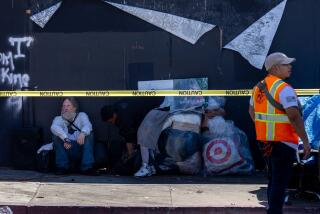Editorial: The city just witnessed the first groundbreaking of an HHH-funded homeless housing project. Finally
- Share via
The dusty mound of earth in East Hollywood may not look like much this Christmas morning, but it will soon give rise to the first tangible evidence of the commitment Los Angeles city voters have made to housing homeless people. Last week officials broke ground on a 122-unit housing project on that site, the first project subsidized by the Proposition HHH bonds approved last year to begin construction.
The work is the second phase of a 187-unit venture by the nonprofit group People Assisting The Homeless that will ultimately provide 141 dwellings for homeless people, along with apartments reserved for veterans and low-income Angelenos. The project is slated to open in relatively short order, in the spring of 2019.
The groundbreaking offers a glimmer of hope for the long, difficult venture to combat homelessness that the city and its residents have embarked upon. What’s particularly heartening is that this project designates so many of its units for homeless people — the most difficult to house and the most desperate for permanent housing. It’s an ambitious start worth celebrating, which may explain why a clutch of elected officials, shovels in hand, happily stood on that pile of dirt and smiled for cameras.
It’s frustrating to watch neighborhoods — and some elected officials — impede the progress of well-designed, even modestly scaled projects.
Of course, the problem of homelessness is orders of magnitude larger than any one project. We all know that. The city’s homeless population rose 20% in 2016, to about 34,000, according to the annual count conducted in January, and the county’s went up 23%, to nearly 58,000. (Who knows what the numbers will be when we do the count, again, next month.)
The city government hasn’t been ignoring the shortage of housing for the homeless; it’s just that progress has been slow. Over the last decade, more than 2,000 units of permanent supportive housing — the kind of units that come with treatment and counseling services — have been completed, and more than 1,000 are in early stages of development with the help of city financing, according to officials of the Los Angeles Housing and Community Investment Department.
One reason for the languid pace of these projects is the complex process of financing them. The PATH Metro Villas Phase 2 project entered the city’s affordable housing pipeline exactly two years ago this month. That’s how long it can take to assemble the patchwork of funding sources necessary for these projects before even getting the final commitment from the city. In this case, $3.5 million of the $54 million budget came from HHH (although the project has other city funding as well). But the guaranteed source of funding that HHH provides for qualifying projects should help quicken the pace significantly — especially since HHH funds can cover a higher percentage of the project cost, which means that developers will not need to seek as many funding sources for each project.
The time required to go from proposal to grand opening should not discourage developers from building projects like these. Yes, the city and developers should also pursue quicker routes to new units; the two they are exploring involve converting motels into housing and assembling prefab units. One thing the city should not do in its haste for solutions, though, is discard permanent housing in favor of just building more shelters.
City officials and nonprofits point out that in the coming year, construction should ramp up. Eight developments with significant funding from HHH money are expected to start construction this coming year. Those will create nearly 500 more units for homeless and very low-income people.
And, while massive projects with hundreds of units for the homeless may not make sense for either developers or residents, we do need to build projects with more than just two or three dozen units for homeless people. Otherwise, we will never reach the scale we need to house them. That’s why it’s frustrating to watch neighborhoods — and some elected officials — impede the progress of well-designed, even modestly scaled projects.
Every community in the city needs to be open to having a portion of the 10,000 units that voters committed to financing through Proposition HHH. It’s true that the homeless crisis has only gotten worse in the past couple of years and encampments have mushroomed. Imagine what the city will look like if we don’t build this housing with some urgency.
Follow the Opinion section on Twitter @latimesopinion or Facebook
More to Read
A cure for the common opinion
Get thought-provoking perspectives with our weekly newsletter.
You may occasionally receive promotional content from the Los Angeles Times.






